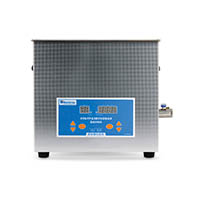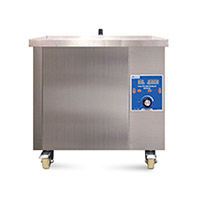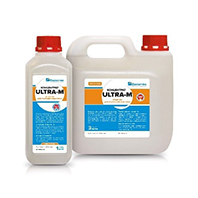Ultrasonic baths
Cleaning in ultrasonic baths
When mechanical cleaning is undesirable or there are hard-to-reach areas, ultrasonic cleaning is used. The process is the following: when high-frequency waves pass through a liquid medium, micro bubbles appear and collapse immediately creating an impact load. This phenomenon is called vapour separation. The dynamic appearance of bubbles at solid (component to be cleaned) — liquid (working medium) interface is used to clean the products surface. However, it is necessary to take into account that an improperly arranged vapour separation process can be ineffective or even lead to component destruction.
To select the ultrasonic cleaning mode, the following shall be taken into account:
- cavitation resistance of contaminants — means the ability of contaminants (fat deposits, paint-and-lacquer coatings, oxides, oxide scales, etc.) to withstand microshock impact;
- adhesion strength of contaminants and surface being cleaned — e.g. adhesion of coating layers, salt deposits, oxide films after heat treatment, etc.;
- degree of chemical effect of contaminants with a washing liquid — dissolution of an oil film, saponification of fats, emulsification of surface contaminants.
Another key point in choosing the ultrasonic cleaning mode is the selection of washing liquid with the necessary characteristics for specified type of work. It is not recommended to use a liquid that interacts more actively with the product material than with contaminants. And also to apply ultrasonic cleaning in cases where the component material is less resistant to cavitation than contaminants. Otherwise, the product to be cleaned will be damaged first.
Selection of ultrasonic cleaning conditions with the necessary characteristics
Vapor pressure
The cavitation intensity depends on the vapor pressure in bubbles. For example, in organic solvents the vapor pressure is greater than in aqueous solutions. Therefore, it is advisable to use water for ultrasonic cleaning. But sometimes “soft” cleaning is needed. For example, in electronics for cleaning radio components, so as not to damage the miniature connections.
Washing liquid viscosity
At a low intensity of ultrasonic exposure, a viscous liquid reduces the cleaning effect, since the loss of sound energy increases. But at a powerful ultrasonic field, the viscosity of the liquid effects on cavitation similarly to increased pressure. It does not allow the bubble to grow, and reduces the time before to be collapsed. Due to this, the power of microshocks increases.
Surface tension
Under the influence of surface tension, the bubbles’ collapse speed increases. On the one hand, this increases the cavitation power, and on the other hand, an increase in surface tension forces leads to an increase in the cavitation threshold and reduces the number of bubbles. In addition, the wetting process worsens. This adversely impacts when cleaning products with micropores and internal cavities. To reduce surface tension, surface-active substances are added to the solution. Wetting quality increases and dissolution of oil films improves.
Solvent composition
The main requirements for ultrasonic cleaning solutions:
- low cost;
- high solubility;
- non-toxicity;
- explosion and fire safety;
- possibility of regeneration;
- temperature condition.
The optimum temperature range for aqueous solutions of washing liquids is +40…+50 °C. If the temperature is lower the solution activity decreases, and if it is higher the vapor pressure increases. This leads to cavitation reducing. In order to reduce bubbles vapor pressure in organic solvents they are cooled up to +15…+20 °C.
Nature of ultrasonic exposure
Typically, the ultrasonic frequency during cleaning is from 18 kHz to 44 kHz. An increase in the oscillation frequency leads to incomplete collapse of the bubble, which significantly reduces the cavitation effect, and the loss of sound energy increases. If frequency lowers, the noise increases.
An increase in ultrasonic intensity can lead to the transformation of a collapsing bubble into an oscillating one. At low intensity, the cavitation power and the efficiency of all accompanying processes reduce.



